engine Citroen C4 AIRCROSS RHD 2014 1.G Owner's Manual
[x] Cancel search | Manufacturer: CITROEN, Model Year: 2014, Model line: C4 AIRCROSS RHD, Model: Citroen C4 AIRCROSS RHD 2014 1.GPages: 368, PDF Size: 20.32 MB
Page 4 of 368
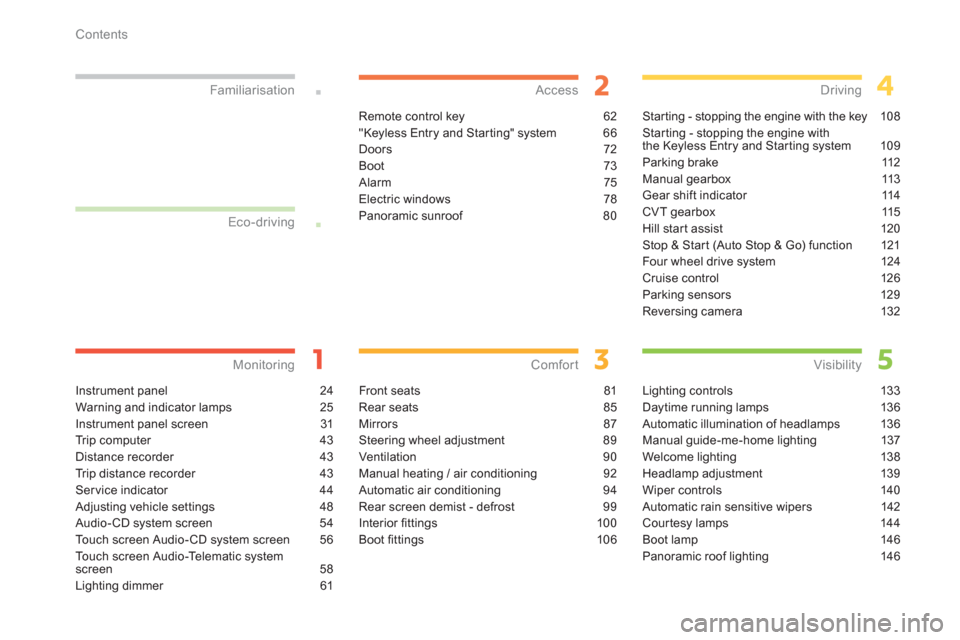
Contents
Instrument panel 24
Warning and indicator lamps 25
Instrument panel screen 31
Tr i p c o m p u t e r 4 3
Distance recorder 43
Trip distance recorder 43
Ser vice indicator 44
Adjusting vehicle settings 48
Audio-CD system screen 54
Touch screen Audio-CD system screen 56
Touch screen Audio-Telematic system
screen 58
Lighting dimmer 61
Monitoring Familiarisation
Remote control key 62
"Keyless Entry and Starting" system 66
Doors 72
Boot 73
Alarm 75
Electric windows 78
Panoramic sunroof 80
Access
Front seats 81
Rear seats 85
Mirrors 87
Steering wheel adjustment 89
Ventilation 9 0
Manual heating / air conditioning 92
Automatic air conditioning 94
Rear screen demist - defrost 99
Interior fi ttings 100
Boot fi ttings 106
Comfort
Starting - stopping the engine with the key 108
Starting - stopping the engine with
the Keyless Entry and Starting system 109
Parking brake 112
Manual gearbox 113
Gear shift indicator 114
CVT gearbox 115
Hill start assist 120
Stop & Start (Auto Stop & Go) function 121
Four wheel drive system 124
Cruise control 126
Parking sensors 129
Reversing camera 132
Driving
Lighting controls 133
Daytime running lamps 136
Automatic illumination of headlamps 136
Manual guide-me-home lighting 137
Welcome lighting 138
Headlamp adjustment 139
Wiper controls 140
Automatic rain sensitive wipers 142
Courtesy lamps 144
Boot lamp 146
Panoramic roof lighting 146
Visibility Eco-driving
Page 5 of 368
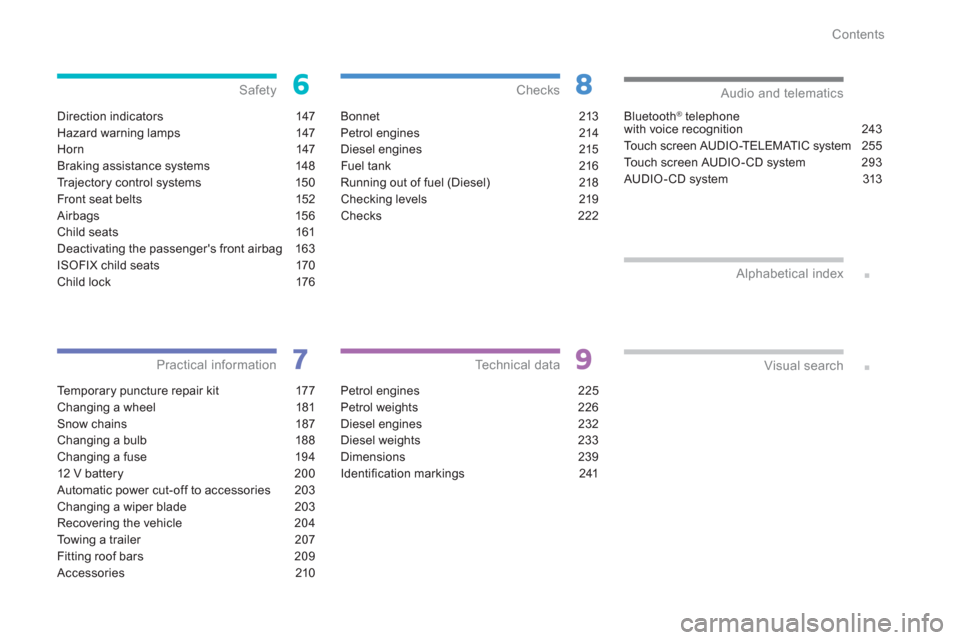
Contents
Direction indicators 147
Hazard warning lamps 147
Horn 147
Braking assistance systems 148
Trajectory control systems 150
Front seat belts 152
Airbags 156
Child seats 161
Deactivating the passenger's front airbag 163
ISOFIX child seats 170
Child lock 176
Safety
Temporary puncture repair kit 177
Changing a wheel 181
Snow chains 187
Changing a bulb 188
Changing a fuse 194
12 V battery 200
Automatic power cut-off to accessories 203
Changing a wiper blade 203
Recovering the vehicle 204
Towing a trailer 207
Fitting roof bars 209
Accessories 210
Practical information
Bonnet 213
Petrol engines 214
Diesel engines 215
Fuel tank 216
Running out of fuel (Diesel) 218
Checking levels 219
Checks 222
Checks
Petrol engines 225
Petrol weights 226
Diesel engines 232
Diesel weights 233
Dimensions 239
Identifi cation markings 241
Te c h n i c a l d a t a
Bluetooth® telephone
with voice recognition 243
Touch screen AUDIO -TELEMATIC system 255
Touch screen AUDIO - CD system 293
AUDIO - CD system 313
Audio and telematics
Alphabetical index
Visual search
Page 6 of 368
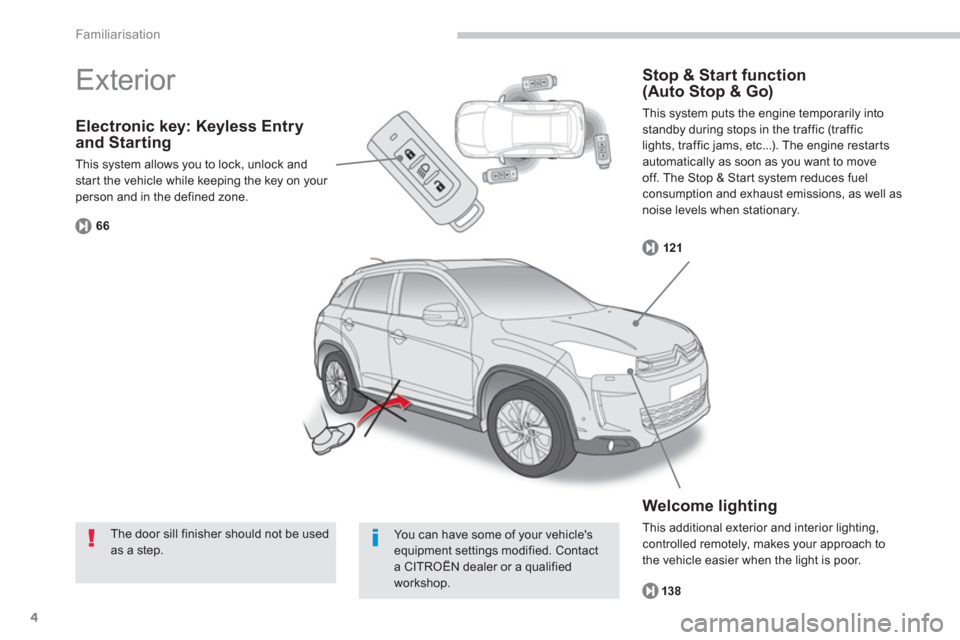
4
Familiarisation
Electronic key: Keyless Entry
and Starting
This system allows you to lock, unlock and
start the vehicle while keeping the key on your
person and in the defined zone.
66
Welcome lighting
This additional exterior and interior lighting,
controlled remotely, makes your approach to
the vehicle easier when the light is poor.
138
Exterior
Stop & Start function
(Auto Stop & Go)
This system puts the engine temporarily into
standby during stops in the traffic (traffic
lights, traffic jams, etc...). The engine restarts
automatically as soon as you want to move
off. The Stop & Start system reduces fuel
consumption and exhaust emissions, as well as
noise levels when stationary.
121
The door sill finisher should not be used
as a step.
You can have some of your vehicle's
equipment settings modified. Contact
a CITROËN dealer or a qualified
workshop.
Page 19 of 368

.
17
Familiarisation
Monitoring
A.
Speedometer dial.
B.
Instrument panel screen.
C.
Rev counter dial.
D.
Lighting dimmer.
E.
INFO button.
Used to cycle through the different
information in the instrument panel screen.
Instrument panel
A.
Passenger's airbag deactivation warning
lamp.
Central switch panel
1.
With the ignition on, the orange and red
warning lamps come on.
2.
With the engine running, these warning
lamps should go off.
If warning lamps remain on, refer to the page
concerned.
Warning lamps
B.
Hazard warning lamps.
C.
Front passenger's seat belt not fastened or
unfastened.
2425157
147
15 3
Page 21 of 368

.
19
Familiarisation
Driving
This six-speed gearbox offers the choice of the
ease of automatic operation or the pleasure of
manual gear changing.
1.
Gear lever.
2.
"-" steering mounted control paddle.
3.
"+" steering mounted control paddle.
CVT gearbox
Display in the instrument panel
The driving mode selected and/or the gear
engaged appear in the instrument panel
screen.
P.
Park.
R.
Reverse.
N.
Neutral.
D.
Drive (Automated mode).
+/-.
Manual mode with sequential gear
changes.
Moving off
From position P
, with the parking brake applied:
�)
Press the brake pedal firmly.
�)
Start the engine.
�)
Then select position R
, D
or +/-
.
�)
Release the parking brake.
�)
Progressively take your foot off the brake
pedal, the vehicle moves off on its own.
115
Page 22 of 368
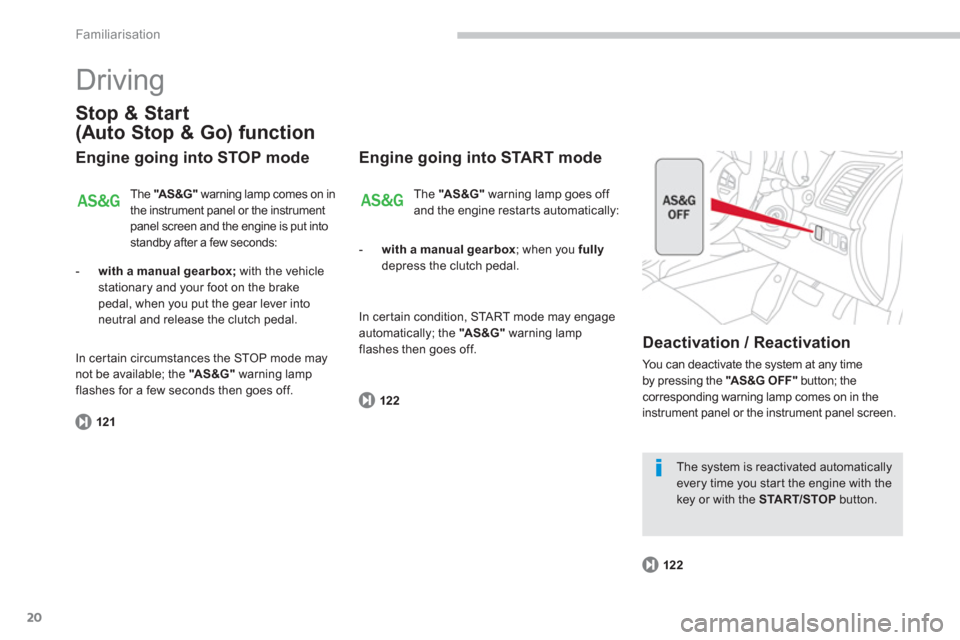
20
Familiarisation
Driving
Stop & Start
(Auto Stop & Go) function
Engine going into STOP mode
The "AS &G"
warning lamp comes on in
the instrument panel or the instrument
panel screen and the engine is put into
standby after a few seconds:
Engine going into START mode
Deactivation / Reactivation
You can deactivate the system at any time
by pressing the "AS &G O FF "
button; the
corresponding warning lamp comes on in the
instrument panel or the instrument panel screen.
The system is reactivated automatically
every time you start the engine with the
key or with the START/STOP button.
The "AS &G"
warning lamp goes off
and the engine restarts automatically:
- with a manual gearbox; when you fully
depress the clutch pedal.
- with a manual gearbox;
with the vehicle
stationary and your foot on the brake
pedal, when you put the gear lever into
neutral and release the clutch pedal. In certain condition, START mode may engage
automatically; the "AS &G"
warning lamp
flashes then goes off.
In certain circumstances the STOP mode may
not be available; the "AS &G"
warning lamp
flashes for a few seconds then goes off.
121122
122
Page 24 of 368
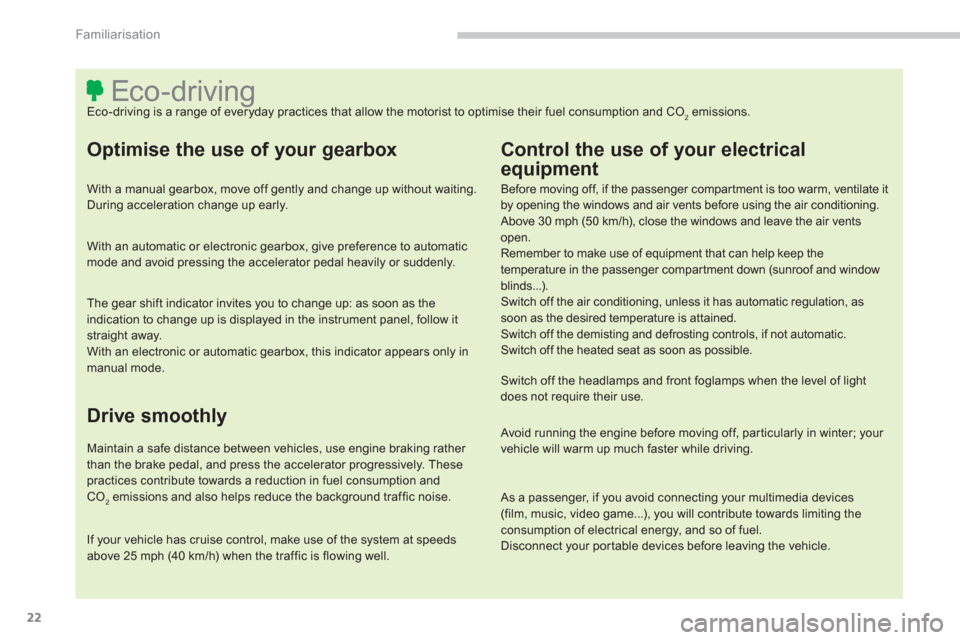
22
Familiarisation
Eco-driving
Eco-driving is a range of everyday practices that allow the motorist to optimise their fuel consumption and CO2 emissions.
Optimise the use of your gearbox
With a manual gearbox, move off gently and change up without waiting.
During acceleration change up early.
With an automatic or electronic gearbox, give preference to automatic
mode and avoid pressing the accelerator pedal heavily or suddenly.
The gear shift indicator invites you to change up: as soon as the
indication to change up is displayed in the instrument panel, follow it
straight away.
With an electronic or automatic gearbox, this indicator appears only in
manual mode.
Drive smoothly
Maintain a safe distance between vehicles, use engine braking rather
than the brake pedal, and press the accelerator progressively. These
practices contribute towards a reduction in fuel consumption and
CO
2 emissions and also helps reduce the background traffic noise.
Control the use of your electrical
equipment
Before moving off, if the passenger compartment is too warm, ventilate it
by opening the windows and air vents before using the air conditioning.
Above 30 mph (50 km/h), close the windows and leave the air vents
open.
Remember to make use of equipment that can help keep the
temperature in the passenger compartment down (sunroof and window
blinds...).
Switch off the air conditioning, unless it has automatic regulation, as
soon as the desired temperature is attained.
Switch off the demisting and defrosting controls, if not automatic.
Switch off the heated seat as soon as possible.
Switch off the headlamps and front foglamps when the level of light
does not require their use.
Avoid running the engine before moving off, particularly in winter; your
vehicle will warm up much faster while driving.
As a passenger, if you avoid connecting your multimedia devices
(film, music, video game...), you will contribute towards limiting the
consumption of electrical energy, and so of fuel.
Disconnect your portable devices before leaving the vehicle.
If your vehicle has cruise control, make use of the system at speeds
above 25 mph (40 km/h) when the traffic is flowing well.
Page 25 of 368
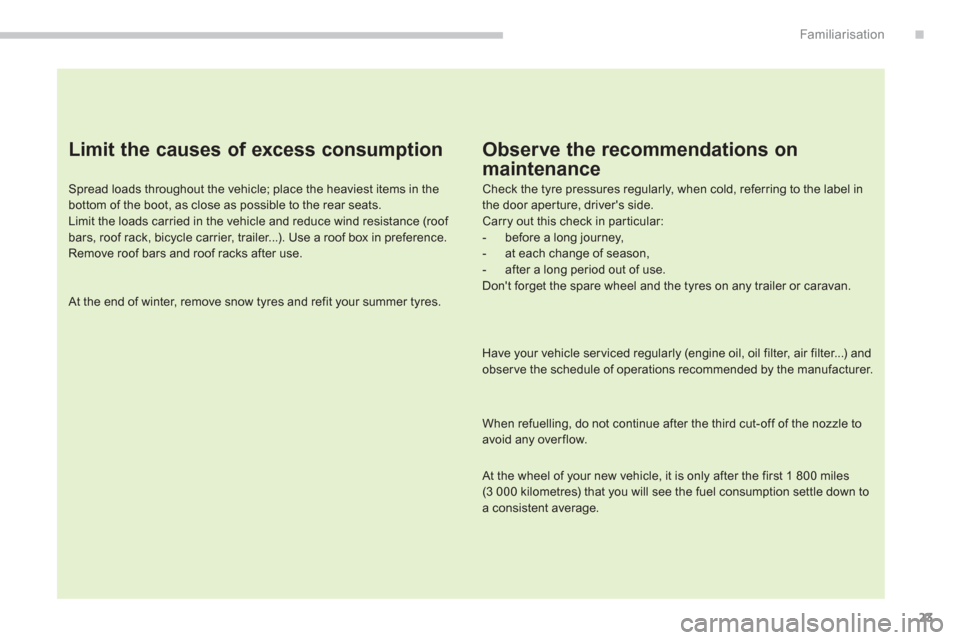
23
.Familiarisation
Limit the causes of excess consumption
Spread loads throughout the vehicle; place the heaviest items in the
bottom of the boot, as close as possible to the rear seats.
Limit the loads carried in the vehicle and reduce wind resistance (roof
bars, roof rack, bicycle carrier, trailer...). Use a roof box in preference.
Remove roof bars and roof racks after use.
At the end of winter, remove snow tyres and refit your summer tyres.
Observe the recommendations on
maintenance
Check the tyre pressures regularly, when cold, referring to the label in
the door aperture, driver's side.
Carry out this check in particular:
- before a long journey,
- at each change of season,
- after a long period out of use.
Don't forget the spare wheel and the tyres on any trailer or caravan.
Have your vehicle ser viced regularly (engine oil, oil filter, air filter...) and
obser ve the schedule of operations recommended by the manufacturer.
When refuelling, do not continue after the third cut-off of the nozzle to
avoid any over flow.
At the wheel of your new vehicle, it is only after the first 1 800 miles
(3 000 kilometres) that you will see the fuel consumption settle down to
a consistent average.
Page 27 of 368
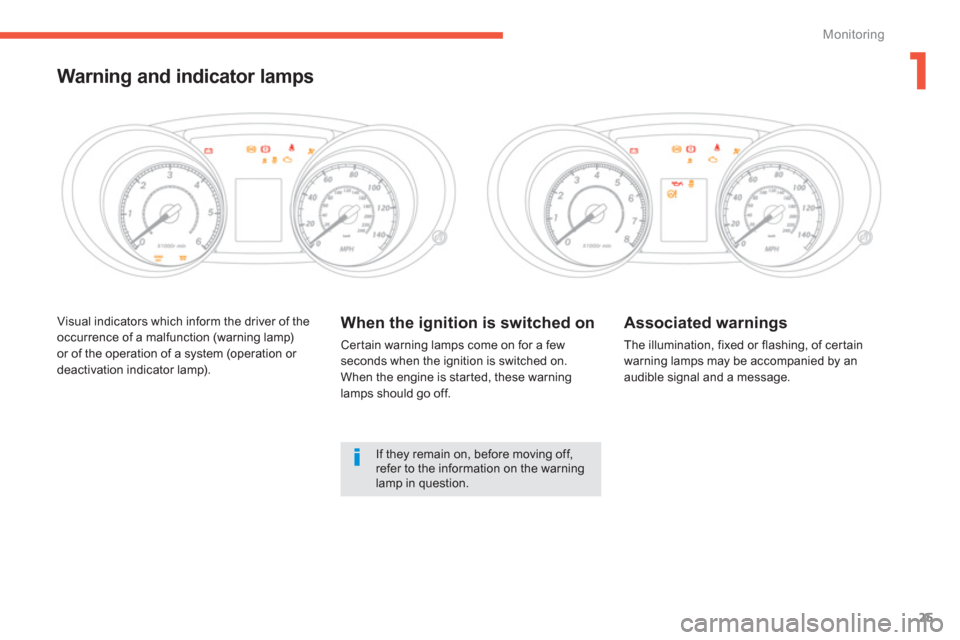
1
25
Monitoring
Visual indicators which inform the driver of the
occurrence of a malfunction (warning lamp)
or of the operation of a system (operation or
deactivation indicator lamp).
When the ignition is switched on
Certain warning lamps come on for a few
seconds when the ignition is switched on.
When the engine is started, these warning
lamps should go off.
Associated warnings
The illumination, fixed or flashing, of certain
warning lamps may be accompanied by an
audible signal and a message.
Warning and indicator lamps
If they remain on, before moving off,
refer to the information on the warning
lamp in question.
Page 28 of 368
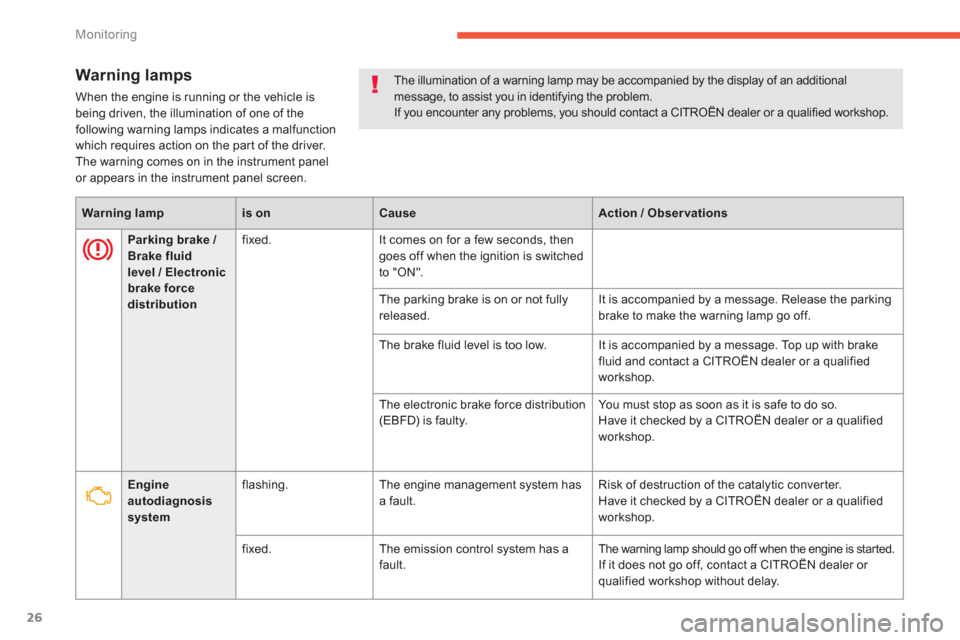
26
Monitoring
Warning lamps
When the engine is running or the vehicle is
being driven, the illumination of one of the
following warning lamps indicates a malfunction
which requires action on the part of the driver.
The warning comes on in the instrument panel
or appears in the instrument panel screen.
Warning lamp
is on
Cause
Action / Observations
Parking brake /
Brake fluid
level / Electronic
brake force
distribution
fixed. It comes on for a few seconds, then
goes off when the ignition is switched
to "ON".
The parking brake is on or not fully
released. It is accompanied by a message. Release the parking
brake to make the warning lamp go off.
The brake fluid level is too low. It is accompanied by a message. Top up with brake
fluid and contact a CITROËN dealer or a qualified
workshop.
The electronic brake force distribution
(EBFD) is faulty. You must stop as soon as it is safe to do so.
Have it checked by a CITROËN dealer or a qualified
workshop.
Engine
autodiagnosis
system
flashing. The engine management system has
a fault. Risk of destruction of the catalytic converter.
Have it checked by a CITROËN dealer or a qualified
workshop.
fixed. The emission control system has a
fault.
The warning lamp should go off when the engine is started.
If it does not go off, contact a CITROËN dealer or
qualified workshop without delay. The illumination of a warning lamp may be accompanied by the display of an additional
message, to assist you in identifying the problem.
If you encounter any problems, you should contact a CITROËN dealer or a qualified workshop.